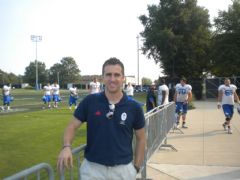The UK Athletics High Performance Centre in London is accommodated in the Lee Valley Athletics Centre, which is also a facility from which the English Institute of Sport provides training & support services to the fencing performance group. Their sports physiotherapist, Ed Mias, recently took some time off after the Olympics to visit some clinicians in North America, with the aim of learning more about the current management of anterior cruciate ligament knee injuries in that part of the World.
Ed has kindly agreed to feedback on his findings & these are his thoughts:
"After almost 4 weeks in the USA & Canada, completely immersed in the prevention & rehabilitation of ACL injuries, I am back to work as a physiotherapist at Lee Valley Athletics Centre.
Over 200,000 ACL tears take place in the USA every year (over half in the female population) & everyone seems to agree that the numbers may increase substantially in the coming years, with the recent success of sports such as female soccer & basketball in the London Olympic Games.
Over the last few years, there has been a big push to improve the rehabilitation post-repair, in order to give the athletes the best chance to go back to high-level sport.. However, the number of athletes who make a full recovery is still not great & rates of re-rupture within the first 18 months are around 30% in the female population.
As a result, there is a trend of researchers (Mandelbaum et al, 2005; Myer et al, 2010; Noyes et al, 2012) developing different screening tests in order to identify those athletes who are at higher risk of suffering from severe knee injury.
Some of the most common factors are the tibial length, athlete’s body mass & hamstring-quadriceps ratio. Some of the latest research published seems to link athletes with long tibial measurement, high body mass & weak quadriceps-hamstring ratios with an increased risk of landing in a position, which could lead to a severe knee injury including ACL tear (Myer et. al 2012).
Another important difference seems to be the preference for the type of graft used, with the patella tendon graft employed more commonly than the hamstring-gracilis one. It appears that there is good evidence to suggest that a hamstring graft could leave a residual weakness on tibial internal rotation for up to 2 years post-surgery leaving the knee joint at risk of further injury (Armour et al, 2004).
Some neuromuscular training programmes have been proven to significantly reduce the incidence of ACL injury (Hewett et al, 2010; Barber-Westin et al, 2010; Myer et al, 2010; Silvers et al, 2005) & the research suggests that these are the best preventative intervention strategies. Everyone I spoke to agrees that the rehabilitation post-repair has improved enormously in the last decade but the way forward is to work harder towards improving the approach to prevention.
This great experience would not have been possible without the support of the Musculoskeletal Association of Chartered Physiotherapists (MACP) that awarded me the Maitland Fellowship."
Thanks for taking the time to report back, Ed & I look forward to learning more from you in this area over the coming months.

